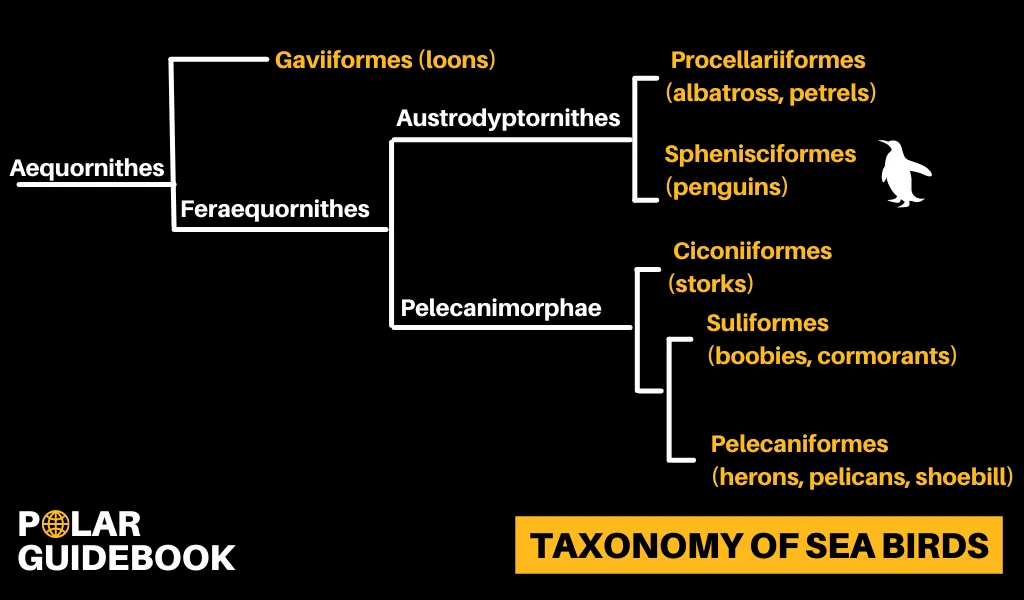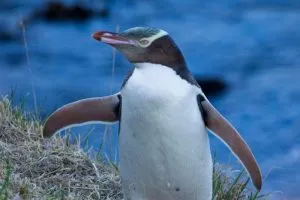Penguins are unique animals in more ways than one. The feathered exterior and beak are akin to birds, but the way they use the water to live and hunt is similar to marine mammals such as seals, walrus, and whales. So, is a penguin a bird or a mammal?
Penguins are birds, and although they are flightless, they share many other characteristics with the rest of the bird family. For example, they are warm-blooded, have feathers and wings, lay eggs, and have a four-chambered heart. They are considered to be flightless aquatic seabirds.
Keep reading to find out where this definition comes from and the similarities of penguins to other birds. You can also check out our epic list of penguin facts to learn more about them.
Why Are Penguins Birds?
Under the scientific classification of animals, which groups all animals together according to their shared characteristics, penguins fall into the class of ‘Aves’ which means birds.
At first, this might not seem right since we typically think of birds as flying animals. However, this is not a prerequisite for a bird and there are other flightless birds too, such as the ostrich and kiwi.
So, why are penguins classed as birds? Well, here are some of the key characteristics that birds have in common according to the Britannica Encyclopedia:
- Have feathers
- Warm-blooded vertebrates
- Four-chambered heart
- Forelimbs modified into wings
- Lay hard-shelled eggs
- Keen vision
- Diurnal (have two legs)
Based on this list, penguins easily meet all of the requirements to be considered birds.

Which Group Does Penguin Belong To?
Penguins are flightless aquatic seabirds. Let’s breakdown each of these things to understand why they are given this definition:
Seabirds
According to their scientific classification, penguins sit within a group of birds called Aequornithes, or core water birds. This also includes storks, herons, and pelicans.
Penguins sit within a sub-group called Austrodyptornithes which also includes tube-nosed seabirds such as albatrosses and petrels. Tube-nosed sea birds are the closest living relatives to the penguin but they diverged around 60 million years ago during a period of global warming1 (source: Li, Cai et al. GigaScience, Vol. 3:1 27, 2014).
Aquatic
Waterbirds or aquatic birds are a group of birds that live in or around water. As well as the seabirds mentioned above, the group also includes flamingos, shorebirds, ducks, swans, and kingfishers.
Adaptations of aquatic birds typically include webbed feet and the ability to dive to catch prey in the water,
Given that penguins spend 75% of their daily lives in water (when they are not incubating their eggs) and can spend months at sea outside of breeding season2 (source: S. Moss, Do Birds Have Knees, 2016), it’s easy to see why penguins are aquatic birds.
Flightless
Flightless birds are those that cannot sustain flapping aerial flight, the group includes 38 flightless land birds, such as the ostrich, emu, and kiwi, and 26 flightless aquatic birds, which include all penguin species and several ducks such as the steamer duck and brown teal3 (source: C. Roots, Flightless Birds, 2006).
It is thought that many flightless birds evolved the trait of being flightless independently of one another and for different reasons based on adaptation to local ecosystems and environment.
How Are Penguins Different From Other Birds?
Despite having the basic characteristics that all birds have in common, there’s no denying that penguins are unique among their kind.
The main difference between penguins and other birds is their strong swimming and diving capability. Whilst most birds have lightweight hollow bones, penguins have dense heavy bones that give them the mass they need to dive as deep as 500m and help them withstand water pressure.
Their bodies are streamlined to cut through the water and they can store air under their feathers which is released as a stream of air bubbles when ascending from great depths in the sea to control buoyancy.
For more information, see our full article on why penguins can swim and dive so well.
The color of penguins is also unique with their black and white tuxedo look which is a technique called countershading and provides camouflage underwater. When seen from above, their black backs blend with the dark ocean underneath but when seen from below, their white bellies blend in with the light coming from the surface.
Why Are Penguins Called Penguins?
According to the Oxford English Dictionary, the word penguin originates from the Welsh words ‘pen gwyn’ which translates as ‘white head’.
The oldest use of the word was in 1577 in the logbook of the Golden Hind ship which stated ‘Infinite were the numbers of the foule, which the Welsh men name Pengwin’. Other Celtic languages such as Breton and Cornish have similar translations4 (source: BBC).
However, it’s likely that the animal being referenced wasn’t a penguin at all and was in fact a great auk.
Penguins are called penguins because sailors in the 1800’s mistook them for the now-extinct great auk which they called penguins. Great auks were flightless black and white birds found near Canada that look similar to penguins, so it’s easy to see why.
Back to the word ‘pen gwyn’ or ‘white head’, it’s unclear if this was a reference to White Head Island where the Great Auk lived or whether it was a reference to the white patches on the face of some penguin species.
Of interest, it was later proven that penguins are not close relatives to the great auk, especially since they are found at opposite ends of the world. The scientific name for the great auk is ‘pinguinus impennis’ which comes from the latin ‘penguin without flight feathers’5 (source: G. Jeremy, Who Killed the Great Auk?, 2000).
Related Questions
Why Aren’t Penguins Fish?
Although they spend most of their time in water, penguins are not fish because they are warm-blooded, have a four-chambered heart, and use wings to swim which is why they are birds.
Conversely, fish are cold-blooded animals with a two-chambered heart and fins6 (source: Sciencing.com). However, penguins do eat fish as part of their diet.
Why Aren’t Penguins Reptiles?
It was originally thought that penguins were the link between dinosaurs and birds which lead some people to mistakenly think that penguins are reptiles. Whilst there is some truth in this since it was later found that all birds are descendants of dinosaurs, penguins are part of the bird family.
Penguins are not reptiles because they are warm-blooded vertebrates with feathers which means they are classified as birds. Conversely, reptiles are cold-blooded vertebrates that have scales over their skin7 (source: University of Georgia).
Why Aren’t Penguins Amphibians?
Penguins can be spotted on land and in water, they use the land for breeding and the sea for foraging, this is why some people might mistake them for amphibians which can also live in water and on land, but the two couldn’t be further apart.
Penguins are not amphibians because they warm-blooded vertebrates that breathe through their lungs and have feathers on their body which means they are birds.
On the other hand, amphibians are cold-blooded animals with smooth/slimy skin that can receive oxygen through their lungs and skin8 (source: University of Georgia).
Is a Penguin a Mammal?
No, Penguins are not mammals, they are flightless birds because they have feathers and wings, and lay eggs which are traits of a bird, not a mammal. There is some confusion because we typically associate birds with flying, but not al birds can fly, including penguins, ostriches, and steamer ducks.

![You are currently viewing Are Penguins Birds or Mammals? [Birds – Here’s Why]](https://polarguidebook.com/wp-content/uploads/2022/01/Are-penguins-birds-or-mammals.jpg)

![Read more about the article 14 Humble Facts About Humboldt Penguins [#6 Will Change How You See Them]](https://polarguidebook.com/wp-content/uploads/2023/01/Humboldt-Penguin-2-300x200.jpg)
